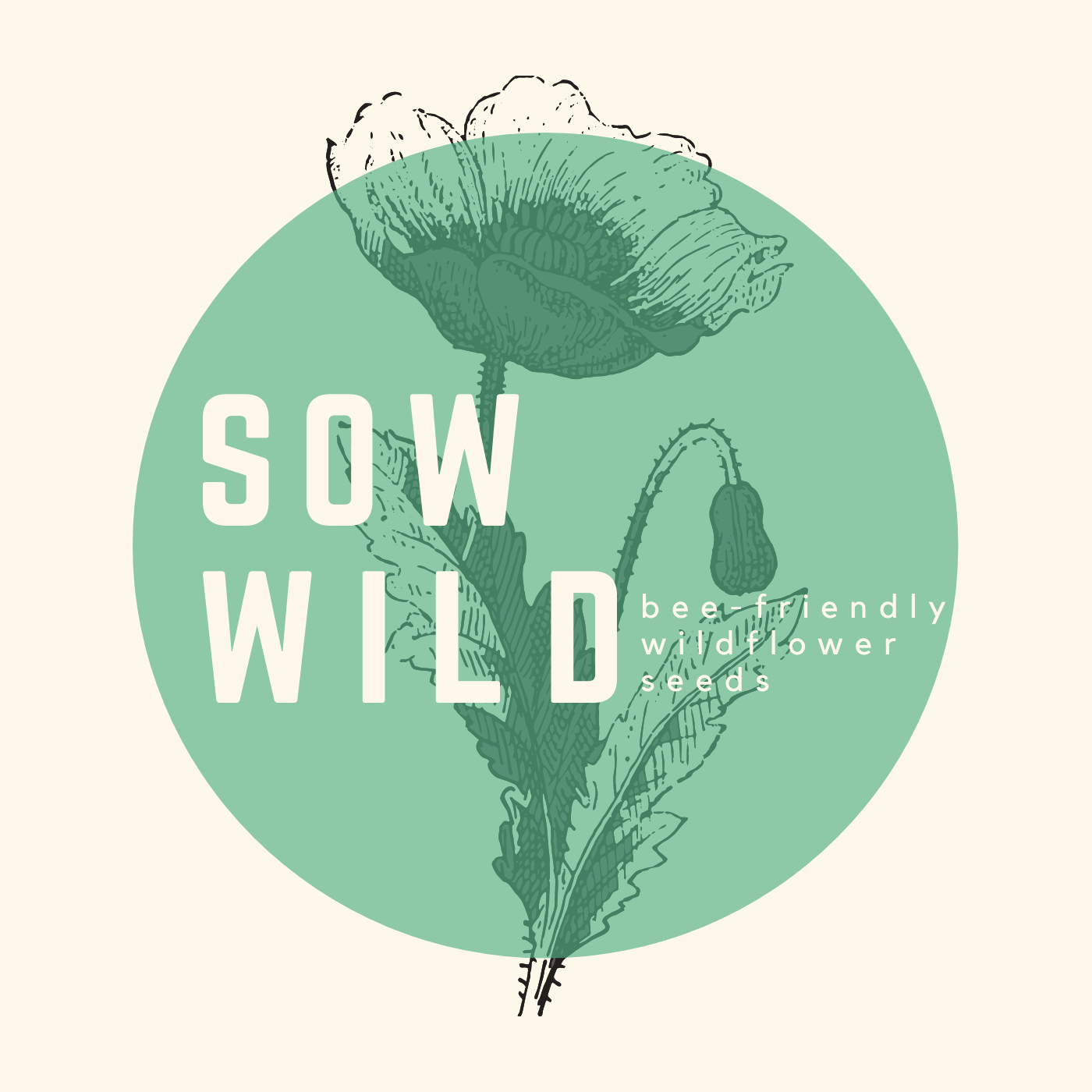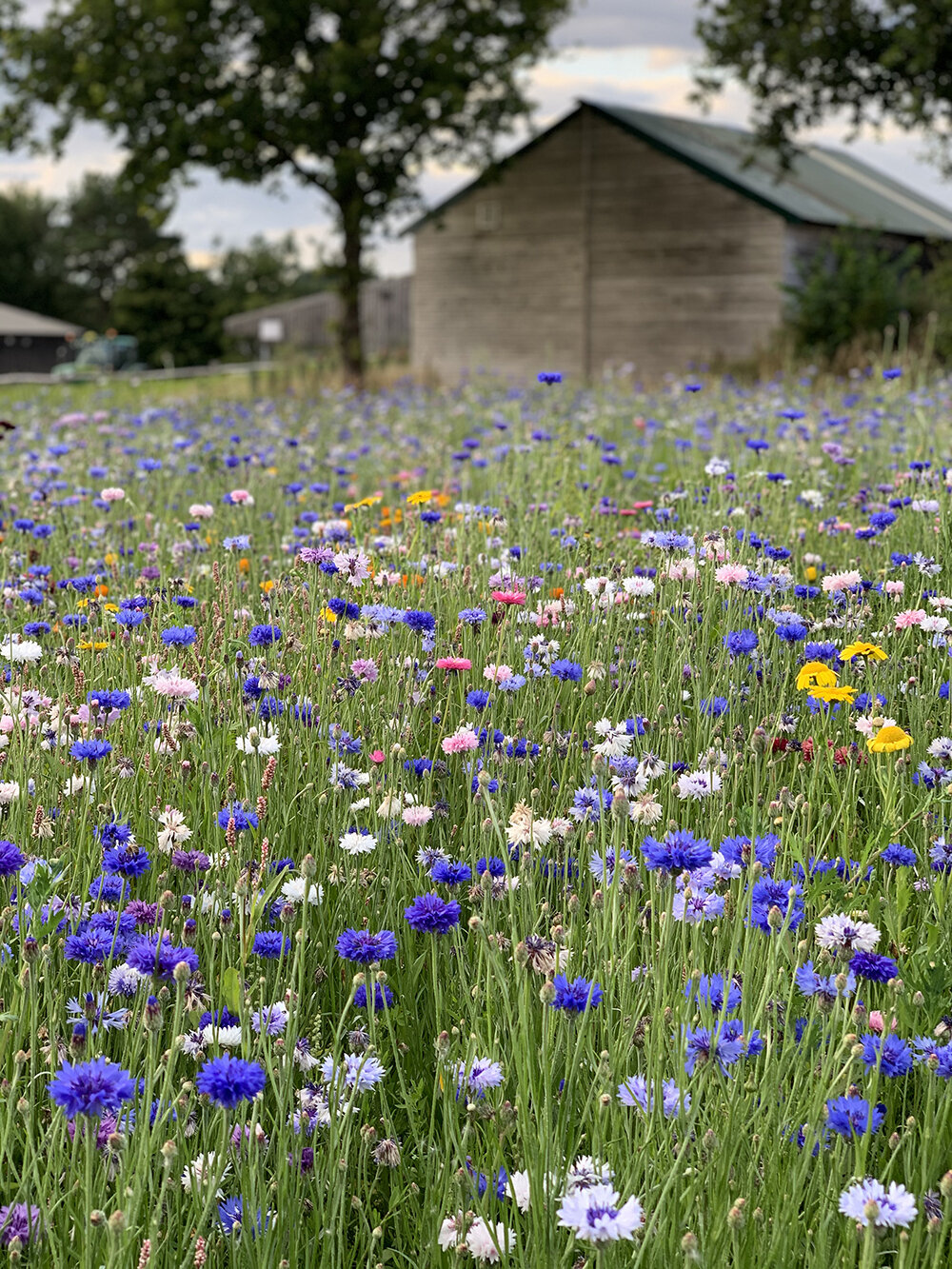A local provenance meadow seed and grass mix can be sown at any time of year, but for best results sow in the autumn. The seed mix should include yellow rattle, a semi-parasitic annual which reduces the strength of the grasses and so helps the more delicate wildflowers to thrive. Some seeds, such as yellow rattle will need a period of cold weather before they will germinate (stratification). If seed is sown in the spring or summer the remaining rattle seed will germinate the following spring after stratification, but we recommend adding extra fresh rattle seed in the autumn.
SITE PREPARATION
A suitable site for a wildflower meadow has full sun, fairly low fertility and few perennial weeds. Any area chosen should be surveyed to establish the flora already present to make sure you are not destroying an area already rich in biodiversity. Also consider the nutritional condition of the soil and the soil type. Any plants or seed brought in should be compatible with the soil conditions and preferably of local origin.
There are several methods for the creation of a wildflower meadow garden. The method chosen will depend upon the size of the area, the current condition and the flora on site and the availability of machinery.
On existing grassland you need to identify the grass species present. This is most easily done in summer when they are in flower. If the grasses are fine-leaved, short (up to 70cm including seed head) and include species such as meadow foxtail, common bent, sweet vernal grass, yorkshire fog and crested dogstail, then the grass can be kept and diversity increased by addition of seed and/or plug plants (see below ‘Adding Diversity to Existing Grassland’). If the grasses present are tall, wide-leaved, clump-forming or form a thick, dense thatch, e.g. couch gras, Deschampsia or a grazing mix rich in rye grass, the turf should be stripped off, sprayed or ploughed in and seed sown into bare soil. It is possible to change this rough or ‘improved’ grassland gradually, by scarification, sowing seed and then hay meadow management, but this method is very slow (10-15 years) and we do not recommend it.
WEEDS
Perennial weeds such as docks, creeping thistles, brambles and nettles are an indicator of fertile soil and their seeds can lie dormant in the soil for many years. If possible you should choose a more suitable site for your wildflower garden. If you are removing areas of these weeds it is well worth devoting an entire growing season to eradicating weeds before sowing in autumn. The site may be ploughed and cleared with one or two applications of weedkiller. The chemical-free method is to spread black plastic mulch for at least six months before sowing or to hand dig the weeds. if you have buttercups identify the species: creeping buttercup is an invasive weed, meadow buttercup is a meadow flower.
After eradication of the weeds we do not plough again or cultivate deeply as this will raise another lot of weed seeds to the surface. Cultivate the top couple of inches of soil to create a firm, fine seed bed.
If you have a bare soil site where perennial weeds are not a problem e.g. an arable field, it is still advisable to cultivate some weeks or months before sowing meadow seed. Any weed seeds which germinate in the seed bed may be sprayed or hoed out before sowing. The common arable weeds such as fat hen, sow thistle, red deadnettle will appear in the first year but they are annuals or biennials and are not going to be a long term problem. You can top them to prevent seed setting but they will soon die out from the meadow as it evolves into a permanent grassland because they are species adapted to disturbed soil.
SOWING
A local provenance meadow seed and grass mix can be sown in spring or autumn, but for best results sow August to October. If your soil is fairly fertile the seed mix should include yellow rattle, a semi-parasitic annual which reduces the strength of the grasses and so helps the more delicate wildflowers to thrive. In some parts of the UK eyebright or red bartsia may occur in place of yellow rattle. Some seeds, such as yellow rattle will need a period of cold weather before they will germinate (stratification). If seed is sown in the spring or summer the rattle seed will germinate the following spring after stratification, but we recommend sowing extra fresh rattle seed in the autumn too. Sow seed into bare soil at 4g/m2 or 40kg/Ha (16kg/acre), you can mix the seed with fine sand or sawdust to make sowing easier and more even. Broadcasting by hand is often easiest. A seed spinner or fertiliser spinner may be useful. Firm the soil by rolling or treading but do not cover, drill or bury the seed. Water in dry period where possible.
ADDING DIVERSITY TO EXISTING GRASSLAND
Existing lawn or pasture can be successfully sown with meadow flowers if it is made up of fine grass species rather than tall, broad-leaved, vigorous or clump-forming grasses (e.g. couch, rye grass, cocksfoot, false oat grass). The sward should be scarified with a rain or chain harrow to create pockets of bare soil making up to one third of the total area. Alternatively every third strip can be sprayed with weedkiller, lightly cultivated and then sowed. The sowing rate on existing grassland is 1-2g/m2 or 10-20kg/Ha (4-8kg/acre). The seed mix used should still be a locally sourced mixed of approx. 30% flower seed and 70% grass seed, and the meadow grasses will gradually replace any less well-adapted existing grasses.
USE OF PLUG PLANTS
Plug plants are small plants which are ready to plant out. PlantWild plugs are larger than most and they will start to flower in the first spring or summer after planting. We recommend up to five plug plants per m2. They can be planted out in the spring or autumn and can go into bare soil at the same time as seed sowing or they can go in later, once the seed has started to establish. In existing grassland they can go in in autumn or spring as long as the sward is cut very short when they are planted. Competition from surrounding grasses can be reduced by spraying or digging out small circles of grass before planting. You may want to choose flowering species which are not present in the seed mix, or use plug plants to enhance a more visible area of a large meadow. It is a good idea to plant plugs in groups of at least five of the same species. This gives a natural look and helps the bees to locate plants when they flower. They can be planted with a small trowel or a dibber the same size as the root ball and must be watered well and prevented from drying out until they are established. When positioning your plugs you may want to consider whether they are early or late flowering (see below ‘When to Cut’). Rabbits enjoy plug plants, if you have a lot of rabbits please protect the plants with fencing, mesh or thorny twigs.
MAINTENANCE
The first year there will be few flowers apart from yellow rattle, any plug plants and a few daisies and clover Cut the sward, keeping it short until the end of March to prevent the stronger-growing grasses from out-competing the slower-growing wildflowers. Remove all cuttings. Weed out or sport-treat any perennial weeds which appear. If a lot of annual weeds appear you may decide to top them by doing a high cut in April. Do not cut later than that as you may risk taking the tops off the yellow rattle plants. The hay cut in the first year can be fairly early. As long as the yellow rattle has set seed (mid July) you can cut for hay, bale or rake off all cuttings. Through the rest of the summer, autumn and winter the sward should be kept short like a lawn either through grazing or mowing (removing all cuttings).
In following years cut the sward until the end of March then leave it to grow up, flower and set seed. Cut the hay any time from late July to September after all the plants have shed their seed. Remove all cuttings to gradually reduce the soil fertility and to avoid leaving a thatch which will inhibit the growth of next years flowers. Regrowth may be mown several times during the autumn and winter to prevent the grasses from becoming too dominant. Alternatively the meadow may be grazed at low intensity between August and March. On a field scale, meadows grazed over autumn or winter tend to be the most successful. Seed or yellow rattle may have to be reintroduced in year two or three. It is an annual and may be lost if it fails to establish and seed in year one or two.
WHEN TO CUT
The decision when to cut your meadow will depend on two factors; the species present and the weather. If you have included plants or seed of late flowering species such as betony, devils-bit scabious, field scabious, yarrow, wild marjoram you will need to leave the meadow standing until September when these plants shed their seed, if not every year at least one in three years. This is not a problem as long as you do not have tough grasses or other perennial weeds threatening to dominate. If so you could cut the weedy areas earlier and more regularly, whilst leaving the late flowering areas to set seed. You may want to consider this when positioning your plug plants in the first place. You could cut earlier (end of July) some years and later (early September) from time to time to allow seed fall from the late flowers. They are all perennial plants so it will not harm them to be cut back early in some years.
Some years the summer is wet and you cannot take machinery onto the land to cut when you would wish to. Compacted ground is very bad for wildflower meadows so do avoid driving on it in wet conditions. If it is too wet then you will have to leave it. If it can be grazed by cattle and/or sheep you could graze without first cutting the grass and this would be better than leaving the grass to flop and rot. At some point over the autumn the sward will need to be cut and cleared even if the hay is useless. Leaving a thick thatch will be very detrimental to the next season’s flowering species and will encourage dominance of grasses and weeds.





